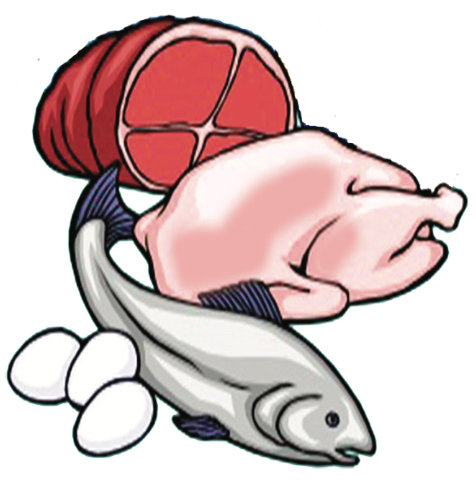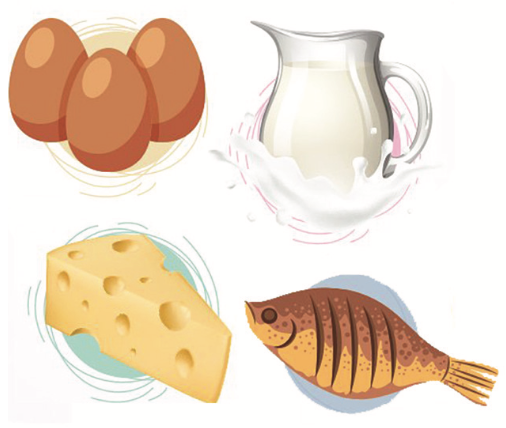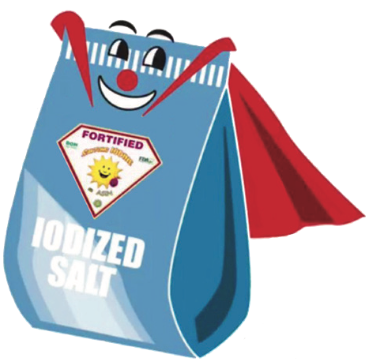
Lesson 1 - Basic Concepts on Food and Nutrition
After completing Lesson 1, you should be able to:
define food, nutrition, nutrients, nutritional status, and malnutrition;
identify the different nutrients, their functions, and food sources; and
discuss the tools for the promotion of good nutrition.
There are five basic concepts to be fully understood in nutrition. These are food, nutrients, nutrition, nutritional status, and malnutrition.
Food, Nutrition, and Nutrition-Related Terms
FOOD. Food is such a common word but sometimes difficult to define. Would anything that gets into your mouth be considered as food? Food is “what people EAT and DRINK to stay alive and healthy, for growth, development, work, and other physical activities.” It implies then that if you do not eat and drink the right food regularly, you will feel sick or have poor health due to lack of nutrients.
NUTRIENT. Can you recall what nutrients are? Nutrients are substances responsible for giving energy, building and repairing body tissues, and regulating body processes. All foods contain nutrients (Figure 1.1). Your body does not produce all essential nutrients, which is why you need to eat food. However, there is no single food that can provide all nutrients required for normal bodily functions. Nutrients work like a team. Thus, it is important to consume a wide variety of foods daily for growth and to maintain optimal health. There are two types of nutrients, macronutrients and micronutrients.
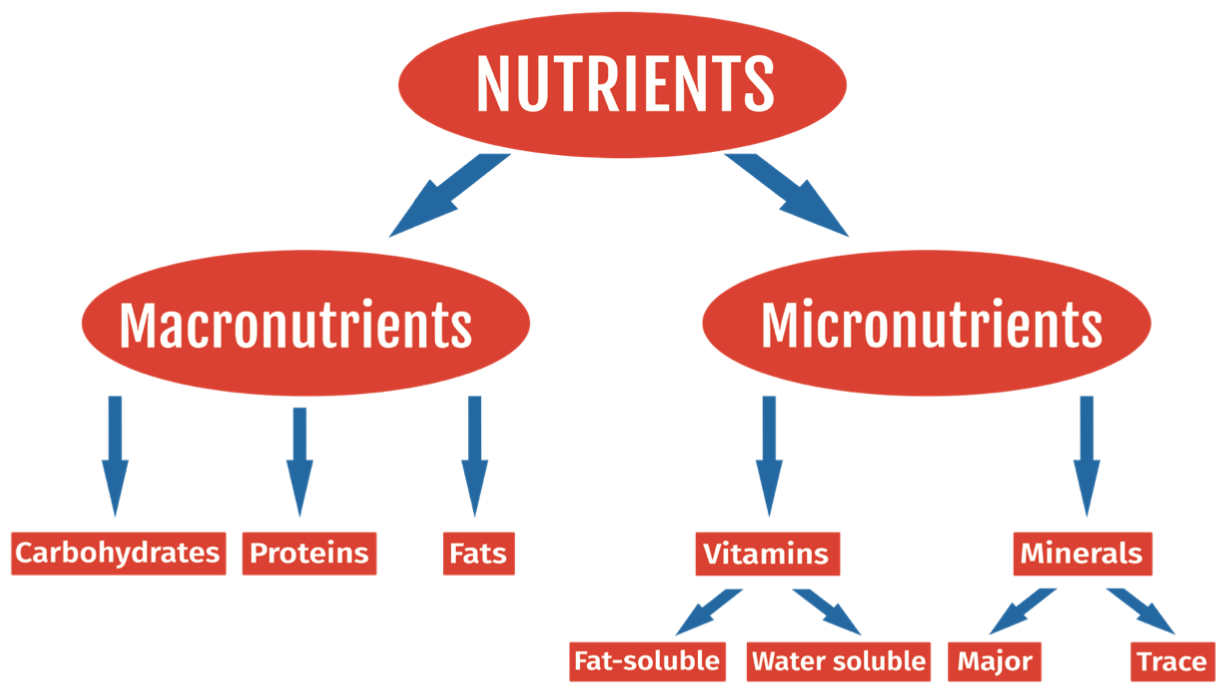 Figure 1.1. Kinds of nutrients
Figure 1.1. Kinds of nutrients
Macronutrients include carbohydrates, protein, and fats. As the word implies, the body needs relatively large amounts of macronutrients (measured in grams) to provide energy (measured in calories). Table 1.1 presents sources and functions of macronutrients.
Micronutrients include vitamins and minerals. Vitamins are further classified into fat-soluble and water-soluble. Fat-soluble vitamins are A, D, E, and K while water-soluble are B and C. Table 1.2 presents sources and functions of vitamins.
Table 1.1. Sources and functions of macronutrients. | ||
Nutrient | Source | Function |
|---|---|---|
Carbohydrates | Rice, cereals, corn, wheat, cassava, potato, ube, taro, sweet potato, sugar | Serve as fuel for energy for body heat and work |
Proteins | Meat, fish, poultry, beans, nuts, egg, milk, cheese, and milk products |
|
Fats | Oils and fats, meat, avocado, nuts, and fried foods |
|
Source: FNRI-DOST, 2000; Antiporda, R.E., 2001
Table 1.2. Sources and functions of micronutrients. | ||
Nutrient | Source | Function |
|---|---|---|
Fat-soluble vitamins | ||
A | Retinol:(readily absorbed form of Vitamin A): Meat, butter, milk, cheese, and eggs |
|
D | Direct exposure to sunlight activates the Vitamin D in the skin |
|
E | Vegetable oils, butter, green vegetables, beans, whole grains, nuts, liver |
|
K | Produced by bacteria in the intestine; also found in green leafy vegetables |
|
Water-soluble vitamins | ||
Ascorbic Acid (Vitamin C) | Citrus fruits, broccoli, strawberries, melon, guava, mango, papaya, cabbage, peppers |
|
Thiamin (B1) | Meats, whole grain and enriched breads, legumes, peanuts, and fresh green vegetables |
|
Riboflavin (B2) | Milk, organ meats, meat, fish, eggs, legumes, whole grains and enriched breads, cereals, cheese, green leafy vegetables |
|
Niacin (B3) | Liver, meat, fish, poultry, peanuts, whole grains and enriched breads and cereals |
|
Pyridoxine (B6) | Meat, fish, poultry, milk, eggs, green vegetables, avocado, beans, bananas, whole grain cereals, potatoes |
|
Folic Acid | Green leafy vegetables, red meats, organ meats, citrus and juice, whole grains, beans, nuts, asparagus, broccoli, spinach |
|
Pantothenic Acid | Organ meats, salmon, eggs, broccoli, mushrooms, pork, whole grains, legumes |
|
Biotin/td> | Organ meats, eggs, milk, whole grains, cereals, and some vegetables |
|
Cobalamin (B12) | Found only in animal products or yeast, meat, fish, poultry, eggs, milk, cheese |
|
Source: FNRI-DOST, 2000; Antiporda, R.E., 2001
Minerals are subdivided into major and trace. Major minerals include calcium, phosphorus, magnesium, sodium, and potassium while trace minerals consist of iron, iodine, and zinc, among others. Table 1.3 shows sources and functions of minerals. This means that a combination of macronutrients and micronutrients are essential for developmental growth. The key is to know the food sources containing macronutrients and micronutrients in planning your nutrition program.
Table 1.3. Sources and functions of micronutrients. | ||
Nutrient | Source | Function |
|---|---|---|
Calcium | Milk and milk products; salmon and small fish with bones; dark green vegetables, legumes |
|
Iron | Chicken, meat, fish, internal organs, legumes, dried fruit, green vegetables, fortified cereals |
|
Fluoride | Fluoridated water, toothpaste and mouth rinses with fluoride |
|
Phosphorous | Milk and milk products, meat, eggs, poultry, nuts, legumes, whole grains |
|
Sodium | Table salt, soy sauce, salty snack foods, foods prepared in brine such as pickles, salty smoked meat or fish, cheeses, canned or instant soup milk, meat, poultry, and eggs |
|
Potassium | Camote, bananas, dried fruits, potatoes, meat, fish, poultry, whole grains, fruits, and vegetables |
|
Magnesium | Green leafy vegetables, nuts, whole grains, meats, milk, seafood, chocolate |
|
Iodine | Iodized salt, seafood, and food grown near the ocean |
|
Zinc | Meat, liver, oysters, fish, milk, whole grains, nuts, and legumes |
|
Source: FNRI-DOST, 2000; Antiporda, R.E., 2001
NUTRITION. Nutrition is defined as the study of how the body uses food. It is the process through which living organisms use food to maintain life, growth, and human functions. NUTRITIONAL STATUS. This refers to the physiological state of an individual.
MALNUTRITION. It is a condition of the body resulting from a deficiency, excess or imbalance in one or more nutrients (Figure 1.2). The topic will be further discussed in Lesson 3.
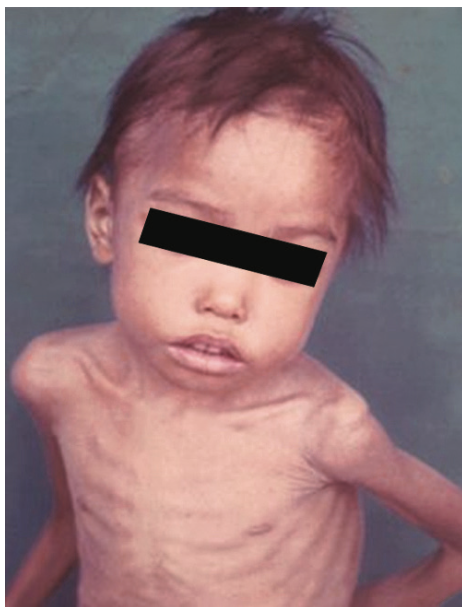 Figure 1.2. A malnourished child
Figure 1.2. A malnourished child
Tools to Promote Proper Nutrition
Nutritional Guidelines for Filipinos (NGF)
The Nutritional Guidelines for Filipinos (NGF) are primary recommendations to promote good health through proper nutrition (FNRI-DOST, 2012). It contains nutrition messages to have a healthy lifestyle for all age groups from infants to adults, pregnant and lactating women, and the elderly. The ten nutritional guidelines are as follows:
| |
| The human body needs more than 40 different nutrients for good health. No single food can provide all the nutrients the body needs. Eating a variety of food from all the different food groups will supply the needed nutrients with the proper amount and balance. |
| |
| Infants and children up to two years old are most vulnerable to malnutrition. Breastfeeding is one of the most effective strategies to improve child survival. Nutritional requirements of an infant can be obtained solely from breastmilk for the first six months of life. After that time, breastmilk must be complemented with appropriate food, but breastfeeding should be continued for up to two years of age or longer. Gawing TSEK ang breastfeeding: Tama, Sapat at Eksklusibo! |
| |
| In general, most Filipinos do not eat enough green leafy and yellow vegetables and vitamin C-rich fruits. Vegetables and fruits are rich sources of micronutrients such as vitamins A and C, iron, and phytochemicals. The consumption of more vegetables and fruits is encouraged to help prevent micronutrient deficiencies. |
| |
| Results of the national nutrition surveys among Filipino households showed that consumption of protein was inadequate based on the Estimated Average Requirement (EAR) of 80% of the Recommended Energy and Nutrient Intake (RENI). Protein is a nutrient that the body needs for growth and maintenance. Aside from lean meat and poultry, some plant-based food are also good sources of protein. |
| |
| National nutrition surveys indicate consistent failure of Filipinos to meet dietary recommendations for calcium. Calcium, together with protein and other nutrients particularly Vitamin D, is essential for the formation of strong bones and teeth. Milk, milk products, small fishes, and shellfishes are excellent sources of calcium and should form part of the daily diet starting from childhood to help prevent osteoporosis later in life. For infants and young children, breastmilk is still the best. |
| |
| In the Philippines, diarrhea is the 3rd leading cause of child illnesses and the 4th leading cause of deaths among children 0-<5 years old. Only 82% of households have access to safe water supply while only 77% have sanitary toilets. Contaminated food and water are the usual sources of infection such as cholera and other diarrheal diseases. Make sure to prepare, serve, and eat food that are safe. |
| |
| Iodine Deficiency Disorders (IDD) is the world’s most common cause of preventable brain damage, and one of the main causes of physical and mental retardation and impaired cognitive development in children. Republic Act 8172 or the Act for Salt Iodization Nationwide (ASIN Law) mandates that all salt for human and animal consumption be iodized. Use iodized salt daily. |
| |
An excessive intake of sodium has been linked to high blood pressure particularly in susceptible individuals. Fried food is high in fats and calories which could lead to weight gain. Fatty foods can increase cholesterol level and increase one’s risk of heart disease and stroke. Sugar-rich food is also high in calories which can contribute to weight gain and obesity. | |
| |
| Overweight prevalence has been climbing at an average rate of 0.67 percentage points per year from 1993 to 2008. Obesity is a major risk factor of non-communicable diseases (NCDs) while underweight increases the risk to infection. These problems are results of prolonged imbalanced energy intake and energy expenditure which later may impose diseases and risks to one’s well-being. |
| |
| About 93% of Filipinos failed to engage in regular leisure and physical activity, 1/3 of Filipino adults are smokers, and 27% are alcohol drinkers which all contribute to the onset of lifestyle related NCDs. Lifestyle related diseases like cardiovascular diseases, chronic obstructive pulmonary disease (COPD), diabetes, cancer, and kidney disorders are among the top leading causes of death (DOH, 2012). Maintaining a healthy diet, engaging in physical activity such as regular exercise, practicing healthy food choices, abstaining from smoking, avoiding alcoholic beverages, and managing stress are key components to a healthy lifestyle, thus, decreasing the risk that NCDs pose to one’s health. |
Ten Kumainments
 Figure 1.3. The 10 Kumainments.
Figure 1.3. The 10 Kumainments.
The National Nutrition Council (NNC) launched its popular version of NGF called the “10 Kumainments.” It aims to promote positive nutrition practices to prevent malnutrition and encourage the adoption of a healthy lifestyle. The nutritional guidelines also aim to address and prevent diet related NCDs such as cancer, diabetes, and cardiovascular diseases.
The 10 Kumainments guidelines are simple and easy to remember that Filipinos can adopt to improve their nutritional status. With messages like “Kumain ng iba’t ibang pagkain,” “Kumain ng gulay at prutas araw-araw,” and “Panatilihin ang tamang timbang,’ individuals are encouraged to eat the right food, exercise right, and pursue a healthy lifestyle in 10 easy rules (Figure 1.3). Alternatively, you can watch the video here:
Play Video
Pinggang Pinoy
Pinggang Pinoy is a new, easy-to-understand food guide that uses a familiar food plate model that conveys the right food group proportions on a per-meal basis to meet an adult’s energy and nutrient needs. It serves as a visual tool to help Filipinos adopt healthy eating habits during mealtimes by delivering effective dietary and healthy lifestyle messages (Figure 1.4).

Figure 1.4. Pinggang Pinoy.
The Food and Nutrition Research Institute (FNRI) of the Department of Science and Technology (DOST) came up with this visual tool to answer the question of what a person should eat per meal in order to be healthy. It also serves as a quick and easy guide to determine the amount of each food group per meal.
Daily Nutritional Guide Pyramid for Filipinos
The Daily Nutritional Guide Pyramid for Filipinos is another tool to educate people on variety, moderation, and proportion of food such that the relative size of each section represents the number of daily servings recommended (Figure 1.5).
The base layer, across the widest part of the pyramid, is for the food group that should be eaten in greatest amount like rice, corn, bread, and cereal. The narrow top shows the group that should be eaten least such as fats, oils, and sugary food.
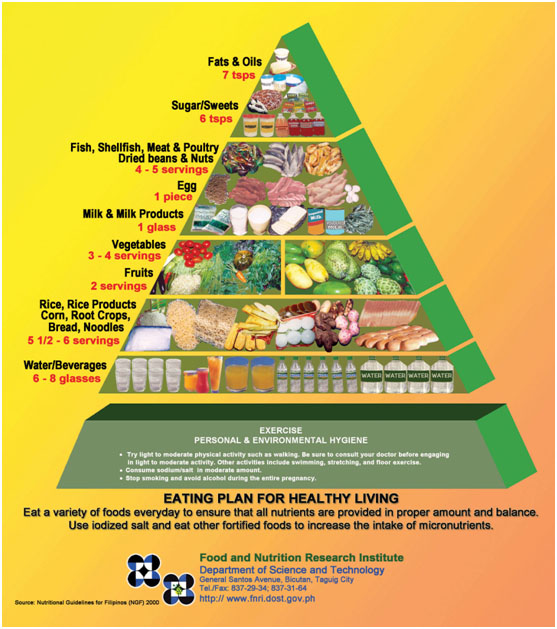 Figure 1.5. The food pyramid guide
Figure 1.5. The food pyramid guide
There are seven guides recommended for the different age and physiological groups (children 1-6 years old, school children, adolescents, adult 20-39 years, pregnant women, lactating women, and older persons) (FNRI-DOST, ND).
Lesson 1 - Basic Concepts on Food and Nutrition
After completing Lesson 1, you should be able to:
define food, nutrition, nutrients, nutritional status, and malnutrition;
identify the different nutrients, their functions, and food sources; and
discuss the tools for the promotion of good nutrition.
There are five basic concepts to be fully understood in nutrition. These are food, nutrients, nutrition, nutritional status, and malnutrition.
Food, Nutrition, and Nutrition-Related Terms
FOOD. Food is such a common word but sometimes difficult to define. Would anything that gets into your mouth be considered as food? Food is “what people EAT and DRINK to stay alive and healthy, for growth, development, work, and other physical activities.” It implies then that if you do not eat and drink the right food regularly, you will feel sick or have poor health due to lack of nutrients.
NUTRIENT. Can you recall what nutrients are? Nutrients are substances responsible for giving energy, building and repairing body tissues, and regulating body processes. All foods contain nutrients (Figure 1.1). Your body does not produce all essential nutrients, which is why you need to eat food. However, there is no single food that can provide all nutrients required for normal bodily functions. Nutrients work like a team. Thus, it is important to consume a wide variety of foods daily for growth and to maintain optimal health. There are two types of nutrients, macronutrients and micronutrients.
 Figure 1.1. Kinds of nutrients
Figure 1.1. Kinds of nutrients
Macronutrients include carbohydrates, protein, and fats. As the word implies, the body needs relatively large amounts of macronutrients (measured in grams) to provide energy (measured in calories). Table 1.1 presents sources and functions of macronutrients.
Micronutrients include vitamins and minerals. Vitamins are further classified into fat-soluble and water-soluble. Fat-soluble vitamins are A, D, E, and K while water-soluble are B and C. Table 1.2 presents sources and functions of vitamins.
Table 1.1. Sources and functions of macronutrients. | ||
Nutrient | Source | Function |
|---|---|---|
Carbohydrates | Rice, cereals, corn, wheat, cassava, potato, ube, taro, sweet potato, sugar | Serve as fuel for energy for body heat and work |
Proteins | Meat, fish, poultry, beans, nuts, egg, milk, cheese, and milk products |
|
Fats | Oils and fats, meat, avocado, nuts, and fried foods |
|
Source: FNRI-DOST, 2000; Antiporda, R.E., 2001
Table 1.2. Sources and functions of micronutrients. | ||
Nutrient | Source | Function |
|---|---|---|
Fat-soluble vitamins | ||
A | Retinol:(readily absorbed form of Vitamin A): Meat, butter, milk, cheese, and eggs |
|
D | Direct exposure to sunlight activates the Vitamin D in the skin |
|
E | Vegetable oils, butter, green vegetables, beans, whole grains, nuts, liver |
|
K | Produced by bacteria in the intestine; also found in green leafy vegetables |
|
Water-soluble vitamins | ||
Ascorbic Acid (Vitamin C) | Citrus fruits, broccoli, strawberries, melon, guava, mango, papaya, cabbage, peppers |
|
Thiamin (B1) | Meats, whole grain and enriched breads, legumes, peanuts, and fresh green vegetables |
|
Riboflavin (B2) | Milk, organ meats, meat, fish, eggs, legumes, whole grains and enriched breads, cereals, cheese, green leafy vegetables |
|
Niacin (B3) | Liver, meat, fish, poultry, peanuts, whole grains and enriched breads and cereals |
|
Pyridoxine (B6) | Meat, fish, poultry, milk, eggs, green vegetables, avocado, beans, bananas, whole grain cereals, potatoes |
|
Folic Acid | Green leafy vegetables, red meats, organ meats, citrus and juice, whole grains, beans, nuts, asparagus, broccoli, spinach |
|
Pantothenic Acid | Organ meats, salmon, eggs, broccoli, mushrooms, pork, whole grains, legumes |
|
Biotin/td> | Organ meats, eggs, milk, whole grains, cereals, and some vegetables |
|
Cobalamin (B12) | Found only in animal products or yeast, meat, fish, poultry, eggs, milk, cheese |
|
Source: FNRI-DOST, 2000; Antiporda, R.E., 2001
Minerals are subdivided into major and trace. Major minerals include calcium, phosphorus, magnesium, sodium, and potassium while trace minerals consist of iron, iodine, and zinc, among others. Table 1.3 shows sources and functions of minerals. This means that a combination of macronutrients and micronutrients are essential for developmental growth. The key is to know the food sources containing macronutrients and micronutrients in planning your nutrition program.
Table 1.3. Sources and functions of micronutrients. | ||
Nutrient | Source | Function |
|---|---|---|
Calcium | Milk and milk products; salmon and small fish with bones; dark green vegetables, legumes |
|
Iron | Chicken, meat, fish, internal organs, legumes, dried fruit, green vegetables, fortified cereals |
|
Fluoride | Fluoridated water, toothpaste and mouth rinses with fluoride |
|
Phosphorous | Milk and milk products, meat, eggs, poultry, nuts, legumes, whole grains |
|
Sodium | Table salt, soy sauce, salty snack foods, foods prepared in brine such as pickles, salty smoked meat or fish, cheeses, canned or instant soup milk, meat, poultry, and eggs |
|
Potassium | Camote, bananas, dried fruits, potatoes, meat, fish, poultry, whole grains, fruits, and vegetables |
|
Magnesium | Green leafy vegetables, nuts, whole grains, meats, milk, seafood, chocolate |
|
Iodine | Iodized salt, seafood, and food grown near the ocean |
|
Zinc | Meat, liver, oysters, fish, milk, whole grains, nuts, and legumes |
|
Source: FNRI-DOST, 2000; Antiporda, R.E., 2001
NUTRITION. Nutrition is defined as the study of how the body uses food. It is the process through which living organisms use food to maintain life, growth, and human functions. NUTRITIONAL STATUS. This refers to the physiological state of an individual.
MALNUTRITION. It is a condition of the body resulting from a deficiency, excess or imbalance in one or more nutrients (Figure 1.2). The topic will be further discussed in Lesson 3.
 Figure 1.2. A malnourished child
Figure 1.2. A malnourished child
Tools to Promote Proper Nutrition
Nutritional Guidelines for Filipinos (NGF)
The Nutritional Guidelines for Filipinos (NGF) are primary recommendations to promote good health through proper nutrition (FNRI-DOST, 2012). It contains nutrition messages to have a healthy lifestyle for all age groups from infants to adults, pregnant and lactating women, and the elderly. The ten nutritional guidelines are as follows:
| |
| The human body needs more than 40 different nutrients for good health. No single food can provide all the nutrients the body needs. Eating a variety of food from all the different food groups will supply the needed nutrients with the proper amount and balance. |
| |
| Infants and children up to two years old are most vulnerable to malnutrition. Breastfeeding is one of the most effective strategies to improve child survival. Nutritional requirements of an infant can be obtained solely from breastmilk for the first six months of life. After that time, breastmilk must be complemented with appropriate food, but breastfeeding should be continued for up to two years of age or longer. Gawing TSEK ang breastfeeding: Tama, Sapat at Eksklusibo! |
| |
| In general, most Filipinos do not eat enough green leafy and yellow vegetables and vitamin C-rich fruits. Vegetables and fruits are rich sources of micronutrients such as vitamins A and C, iron, and phytochemicals. The consumption of more vegetables and fruits is encouraged to help prevent micronutrient deficiencies. |
| |
| Results of the national nutrition surveys among Filipino households showed that consumption of protein was inadequate based on the Estimated Average Requirement (EAR) of 80% of the Recommended Energy and Nutrient Intake (RENI). Protein is a nutrient that the body needs for growth and maintenance. Aside from lean meat and poultry, some plant-based food are also good sources of protein. |
| |
| National nutrition surveys indicate consistent failure of Filipinos to meet dietary recommendations for calcium. Calcium, together with protein and other nutrients particularly Vitamin D, is essential for the formation of strong bones and teeth. Milk, milk products, small fishes, and shellfishes are excellent sources of calcium and should form part of the daily diet starting from childhood to help prevent osteoporosis later in life. For infants and young children, breastmilk is still the best. |
| |
| In the Philippines, diarrhea is the 3rd leading cause of child illnesses and the 4th leading cause of deaths among children 0-<5 years old. Only 82% of households have access to safe water supply while only 77% have sanitary toilets. Contaminated food and water are the usual sources of infection such as cholera and other diarrheal diseases. Make sure to prepare, serve, and eat food that are safe. |
| |
| Iodine Deficiency Disorders (IDD) is the world’s most common cause of preventable brain damage, and one of the main causes of physical and mental retardation and impaired cognitive development in children. Republic Act 8172 or the Act for Salt Iodization Nationwide (ASIN Law) mandates that all salt for human and animal consumption be iodized. Use iodized salt daily. |
| |
An excessive intake of sodium has been linked to high blood pressure particularly in susceptible individuals. Fried food is high in fats and calories which could lead to weight gain. Fatty foods can increase cholesterol level and increase one’s risk of heart disease and stroke. Sugar-rich food is also high in calories which can contribute to weight gain and obesity. | |
| |
| Overweight prevalence has been climbing at an average rate of 0.67 percentage points per year from 1993 to 2008. Obesity is a major risk factor of non-communicable diseases (NCDs) while underweight increases the risk to infection. These problems are results of prolonged imbalanced energy intake and energy expenditure which later may impose diseases and risks to one’s well-being. |
| |
| About 93% of Filipinos failed to engage in regular leisure and physical activity, 1/3 of Filipino adults are smokers, and 27% are alcohol drinkers which all contribute to the onset of lifestyle related NCDs. Lifestyle related diseases like cardiovascular diseases, chronic obstructive pulmonary disease (COPD), diabetes, cancer, and kidney disorders are among the top leading causes of death (DOH, 2012). Maintaining a healthy diet, engaging in physical activity such as regular exercise, practicing healthy food choices, abstaining from smoking, avoiding alcoholic beverages, and managing stress are key components to a healthy lifestyle, thus, decreasing the risk that NCDs pose to one’s health. |
Ten Kumainments
 Figure 1.3. The 10 Kumainments.
Figure 1.3. The 10 Kumainments.
The National Nutrition Council (NNC) launched its popular version of NGF called the “10 Kumainments.” It aims to promote positive nutrition practices to prevent malnutrition and encourage the adoption of a healthy lifestyle. The nutritional guidelines also aim to address and prevent diet related NCDs such as cancer, diabetes, and cardiovascular diseases.
The 10 Kumainments guidelines are simple and easy to remember that Filipinos can adopt to improve their nutritional status. With messages like “Kumain ng iba’t ibang pagkain,” “Kumain ng gulay at prutas araw-araw,” and “Panatilihin ang tamang timbang,’ individuals are encouraged to eat the right food, exercise right, and pursue a healthy lifestyle in 10 easy rules (Figure 1.3). Alternatively, you can watch the video here:
Play Video
Pinggang Pinoy
Pinggang Pinoy is a new, easy-to-understand food guide that uses a familiar food plate model that conveys the right food group proportions on a per-meal basis to meet an adult’s energy and nutrient needs. It serves as a visual tool to help Filipinos adopt healthy eating habits during mealtimes by delivering effective dietary and healthy lifestyle messages (Figure 1.4).

Figure 1.4. Pinggang Pinoy.
The Food and Nutrition Research Institute (FNRI) of the Department of Science and Technology (DOST) came up with this visual tool to answer the question of what a person should eat per meal in order to be healthy. It also serves as a quick and easy guide to determine the amount of each food group per meal.
Daily Nutritional Guide Pyramid for Filipinos
The Daily Nutritional Guide Pyramid for Filipinos is another tool to educate people on variety, moderation, and proportion of food such that the relative size of each section represents the number of daily servings recommended (Figure 1.5).
The base layer, across the widest part of the pyramid, is for the food group that should be eaten in greatest amount like rice, corn, bread, and cereal. The narrow top shows the group that should be eaten least such as fats, oils, and sugary food.
 Figure 1.5. The food pyramid guide
Figure 1.5. The food pyramid guide
There are seven guides recommended for the different age and physiological groups (children 1-6 years old, school children, adolescents, adult 20-39 years, pregnant women, lactating women, and older persons) (FNRI-DOST, ND).



